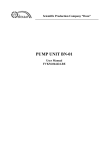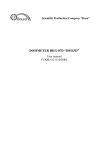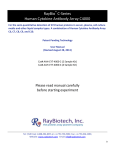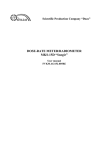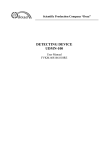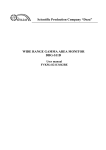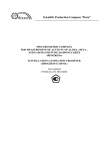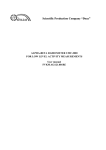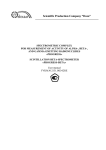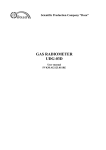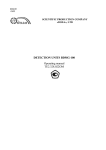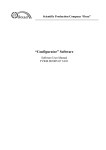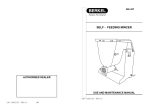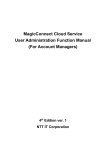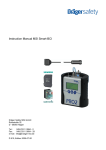Download User Manual
Transcript
Scientific Production Company “Doza” DOSIMETER DKG-02U “ARBITER” User manual FVKM.412113.028RE Cont ent 1 Description and operation of the product …………………………..………. 1.1 Product functionality …………………………………….………… 1.2 Technical characteristics ……………………………………..……. 1.3 Design and operation …………....……………..…………………... 1.4 Marking and sealing …………………...……………...…………… 1.5 Packing ……………………………………………...……………... 2 Intended use ………………………………………………..…………….… 2.1 Operational limitations ………………………………..…………… 2.2 Preparation of the product for use ..…………………..….………… 2.3 Use of a product …….….….………………………………………. 2.3.1 Turning on/off …….….….………………………………………. 2.3.2 Selection of operation mode …….….….………………………… 2.3.3 Start and stop of measurement ………………………...………… 2.3.4 “Single measurement of AEDR” mode .….……………………… 2.3.5 “Search” mode…….….….……………………………………..… 2.3.6 “Continuous measurement of AEDR and AED” mode ……..…… 2.3.7 “Total AED” indication mode ……………………………...……. 2.3.8 Setting time, date and statistical uncertainty ………………..…… 2.3.9 Archive of single measurement of AEDR results …….…….…… 2.3.10 Setting thresholds for audible alarm ……………………………. 2.3.11 Turning audible alarm on/off ……………………………...……. 2.3.12 Transfer of achieved measurement results to PC ………….…… 2.3.13 Battery replacement ….….…………………………………..…. 2.4 Adjustment ……………………………….……………………...… 3 Maintenance …………………………………………………………...…… 3.1 General notes …………………………………………………..…... 3.2 Safety precautions ……………………………………………….… 3.3 Maintenance routine …………………………………………...…... 4 Calibration routine ………………………….…………………...….……… 4.1 General requirements …………………………................................ 4.2 Preliminary arrangements ……………………………..………....… 4.3 Safety precautions ……………………………………………….… 4.4 Conditions …….……….………….………….………….………… 4.5 Procedure …………………….…………………..……………..….. 5 Routine repairs …………………………………………..………………..... 6 Storage …………………………………………………………...………… 7 Transportation …………………………………………………….…….….. 8 Disposal ……………………………………………………….……………. FVKM.412113.028RE 2 3 3 3 4 4 5 5 5 5 5 5 5 6 6 7 7 8 8 8 8 9 9 10 10 10 10 10 11 11 11 11 12 12 12 14 14 15 15 This User Manual contains information on design, principle of operation, characteristics of the product and instructions essential for correct and safe use of this product (intended use, maintenance, servicing, storage and transportation), as well as information regarding the utilization of the product. 1 DESCRIPTION AND OPERATION OF THE PRODUCT 1.1 Product functionality Dosimeter DKG-02U “Arbiter” FVKM.412113.028 (hereinafter - dosimeter) is intended for measurement of: * 10 of gamma radiation (hereinafter - AEDR); - ambient equivalent dose rate Н - ambient equivalent dose Н* 10 of gamma radiation (hereinafter - AED). The dosimeters are used at nuclear plants and facilities, at radiochemistry plants, in industries where radiation sources are used, at special and custom control stations, and by ecological services and sanitary inspections. The dosimeter can also be used by persons from population for individual monitoring of radiation environment. 1.2 Technical characteristics 1.2.1 Energy range of measured gamma radiation ……….....….…….….....…. 0.05 to 3.0 MeV. 1.2.2 Measurement range: - AEDR of gamma radiation ………………………...………………... 1·10-1 to 3·106 μSv·h-1; - AED of gamma radiation ……………………….……………………..…….. 1 to 1·108 μSv. 1.2.3 Limits of the permissible basic relative measurement error: ) %; - AEDR of gamma radiation ..………..……………..….……..…………… (15+3/ - AED of gamma radiation ..……………………….………………...……… (15+3/H) %, , H are dimensionless units, numerically equal to measured values of measured AEDR or where AED in μSv·h-1 and μSv, accordingly. 1.2.4 Energy dependence relative to 137Cs (0.662 MeV) ……………………………….. 25 %. 1.2.5 Anisotropy of dosimeter at energy 0.662 MeV for angles of incident radiation from 0 to ±180° relative to vertical axis passing through the dosimeter’s geometric center ……………… 30 %. 1.2.6 Power supply of the dosimeter is carried out from two batteries of AA type with total voltage ………………………………………………………………………..…… not more than 3.3 V. 1.2.7 Dosimeter is stable with power supply voltage in the range ………...… from 1.8 to 3.3 V. 1.2.8 Warm-up time of the dosimeter ….….…..………….…..…..…………. not more than 5 s. 1.2.9 Continuous operation with one set of batteries ……..…..…….… not less than 100 hours. 1.2.10 Instability of readings during 8 hours of continuous operation relative to average value of readings for this period of time ……………………….…………….……………….………… ±5 %. 1.2.11 Thresholds for audible alarm are set with precision ……………………………… ±1 % within the whole measurement range of AEDR and AED of gamma radiation. 1.2.12 Measurement interval for natural background AEDR level of 0.1 μSv·h-1 not more than 35 s, with uncertainty not more than ±50 %. The measurement interval decreases inversely with AEDR. 1.2.13 Data remain in the dosimeter’s memory without limitation in time after batteries are discharged or absent. 1.2.14 Operating conditions: - operating temperature range: ……...….….……………….…….....….. minus 20 to + 50 C; - maximum limit of relative humidity …………….….……..………..….…… 90 % at +25 C; - atmospheric pressure ………………………………………………….… 84.0 to 106.7 kPa; - content of the corrosive agents in the ambient air corresponds to the values in Table 1.1. FVKM.412113.028RE 3 Table 1.1 Type of atmosphere Designation Designation I Relatively clean II Industrial Content of the corrosive agents Sulfur dioxide gas not more than 20 mg/(m2·day) (not more than 0.025 mg/m3); Chlorides not more than 0.3 mg/(m2·day) Sulfur dioxide gas not more than 20 to 250 mg/(m2 ·day) (not more than 0.025 to 0.31 mg/m3); Chlorides not more than 0.3 mg/(m2·day) 1.2.15 Limits of complementary measurement error of AEDR/AED of gamma radiation due to deviation of temperature from normal value, per each 10°C ……………………………..……... ±10 %. 1.2.16 Degree of protection provided by dosimeter’s casings against ingress of solid items and water ……………………..…………………..…..……...……………………... IP65. 1.2.17 Dosimeter is stable against electromagnetic interference of 2 grade according to IEC 61000-4-2-95, IEC 61000-4-3:2006. 1.2.18 By its protection against electric shock dosimeter complies with the IEC 61010-1:2001. 1.2.19 Dosimeter is a fire-safe product with fire probability of fire not more than 10-6 year-1. 1.2.20 Design, materials and coverings of the dosimeter allow performing multiple efficient decontamination using decontamination solutions: - boric acid (H3BO3) – 16 g, sodium thiosulfate (Na2S2O3·5H2O) – 10 g, distilled water – up to 1 liter; - 5 % citric acid solution in rectified alcohol. 1.2.21 Weight of the dosimeter, including batteries ………………….…...…..…………. 0.3 kg. 1.2.22 Overall dimensions of the dosimeter ..…………………………........…. 8215232 mm. 1.2.23 Dosimeter does not contain precious materials. 1.2.24 Mean time to failure …………….……….………….…..….…. not less than 4500 hours. 1.2.25 Mean life time ……………………….….………….……….…..…. not less than 7 years. 1.3 Design and operation 1.3.1 All modules of the dosimeter are placed in compact leak proof plastic case. In the upper part of the dosimeter’s front panel a liquid-crystal display (hereinafter - LCD) is provided, in the middle part multifunctional control buttons are situated and a window of the infrared (IR) communication channel with PC. 1.3.2 The principle of operation of the dosimeter is based on counting of pulses from GM counters of the following type: Beta-2M (sensitive) and Gamma-1 (high-level), which are switched on/off automatically depending on measured radiation level. The built-in converter provides high voltage 400 V for the counters. Data processing is carried out by microcontroller, obtained measurement result is displayed on the LCD. 1.4 Marking and sealing 1.4.1 The following information is presented at the dosimeter’s case: - trademark and name of the manufacturer (supplier); - reference designation of the dosimeter; - works number of a dosimeter according to the manufacturer's system of numeration; - degree of ingress protection against solid items and water provided by casings. 1.4.2 The dosimeter is sealed in accordance with the design documentation. FVKM.412113.028RE 4 1.5 Packing 1.5.1 The dosimeter is packed into a carton which ensures protection against ingress of atmospheric precipitations and aerosols, splashes of water, dust, sand, solar ultra-violet radiation and also limits the ingress of water vapour and gases. 2 INTENDED USE 2.1 Operational limitations 2.1.1 Dosimeter retains operability under conditions stated in sect. 1.2.14. 2.1.2 Avoid dropping of a dosimeter and protect it from shocks. 2.1.3 If a dosimeter is attached to the clothes the LCD shall be oriented towards the body. 2.2 Preparation of the product for use 2.2.1 If batteries are inserted into the battery compartment the dosimeter is ready for use. In case batteries are not inserted, insert them as described in 2.3.13. 2.3 Use of dosimeter 2.3.1 Turning on/off 2.3.1.1 Turning on Turning on of the dosimeter is performed by pressing the button “ON/OFF”. After turning on the dosimeter is always in the default mode “Single measurement of AEDR”. If measurement is not started in four minutes after turning the dosimeter on, it will be turned off automatically. Automatic turning off will be activated also in the process of operation if next measurement is not started in 4 minutes after the end of a measurement. 2.3.1.2 Turning off To turn the dosimeter off stop measurement by pressing the button “START/STOP” than press the button “ON/OFF”, you will hear interrupted audible signal and a message “Turning OFF” will appear on the LCD. ATTENTION! FOR ALL OPERATION MODES TURNING THE DOSIMETER OFF IS POSSIBLE ONLY AFTER STOPPING OF MEASUREMENT BY “START/STOP” BUTTON. 2.3.2 Selection of operation mode 2.3.2.1 The dosimeter has four modes of operation and displaying of results: - “Single measurement of AEDR”; - “Search” – search of sources of ionizing radiation and measurement of count rate of detected photons; - “Continuous measurement of AEDR and AED”; - Total AED” – indication of total AED accumulated by the dosimeter since the moment when it was first turned on. 2.3.2.2 For using specific mode perform the following steps: 1) first turning on: turn the dosimeter on by pressing the “MODE” button in sequence until the necessary mode is selected then press the “START/STOP” button for start of measurement; 2) during operation: - stop the measurement process by pressing the “START/STOP” button until an audible signal is heard, - by pressing the “MODE” button in sequence select necessary mode of operation and press the button “START/STOP” to start measurement. FVKM.412113.028RE 5 2.3.2.3 Prevention of accidental switches when the dosimeter is worn on the clothes a delay is provided when pressing the “START/STOP” button – it is necessary to press and hold the button for about 2 seconds. Command by this button is acknowledged by audible signal. ATTENTION! EXECUTION OF ANY COMMAND AFTER PRESSING A BUTTON IS ACKNOWLEDGED BY AUDIBLE SIGNAL. 2.3.3 Starting and stopping of the measurement process 2.3.3.1 Starting of the measurement process in any operation mode is performed by pressing “START/STOP” button. The button “START/STOP” shall be released only after audible signal is heard, at that the measurement process is acknowledged: - in the “Single measurement of AEDR” mode – by presence of pulsing square in the upper left part of LCD and by dashed line in place of AEDR value; - in the “Continuous measurement of AEDR and AED” mode – by presence of pulsing square in the upper left part of LCD; - in the “Search” mode – by change of timer indication in the upper left part of LCD and by counting of pulses in the upper part of LCD, by change of the length of linear scale for indication of count rate, as well as by audible signals, which accompany detection of each pulse. 2.3.3.2 During the first three seconds measurement is performed by counter Gamma-1 with low sensitivity then, if the AEDR value is in the range of sensitive counter, an automatic switch to the sensitive counter Beta-2M will be performed and the measurement will be restarted. At that the symbol of switching between counters will appear on the LCD. Dimension of measurand in any mode of measurement is set automatically in accordance with measured quantity – AEDR in μSv·h-1/mSv·h-1/Sv·h-1, AED in μSv/mSv/Sv. 2.3.3.3 Measurement process can be stopped by pressing a “START/STOP” button. 2.3.4 Mode of operation “Single measurement of AEDR” 2.3.4.1 Select “Single measurement of AEDR” mode, start the measurement process by pressing the “START/STOP” button. During the measurement process the following information is displayed: - in the upper line: in the upper left corner – current time (hours and minutes), in the center – current date (date, month and year), in the upper right corner – battery state symbol; - symbols displayed under current time indicate type of counter used for measurement: sensitive counter Beta-2M, - low sensitivity counter Gamma-1, - symbol of audible signal, accompanying buttons pressing and ending of the measurement process, pulsing square, which indicates that the measurement process is under way; - in the center – measured value of AEDR in μSv·h-1 /mSv·h-1/Sv·h-1 ; - in the lower left corner – value of the statistical uncertainty of measurement in per cents, above it the number of measurement is displayed under which the measurement result can be stored in the archive, presence of triangular brackets around the measurement number indicates that the measurement result is not currently stored in the nonvolatile memory. 2.3.4.2 Measurement interval depends on the AEDR value and on final statistical uncertainty of measurement set by the user. In the beginning of the measurement maximum statistical uncertainty is displayed 199%, which decreases during the measurement process and approaches to the selected value. After the selected value of statistical uncertainty is reached the measurement process stops and final value of AEDR is displayed in corresponding measurement units. Setting of desired final statistical uncertainty can be performed in accordance with 2.3.8. FVKM.412113.028RE 6 After next pressing of the “START/STOP” button the next measurement will be performed and so on. The result of single measurement of AEDR, together with time, date, measurement uncertainty and short comment can be stored in the nonvolatile memory in accordance with 2.3.9. 2.3.4.3 If during measurement process the AEDR value exceeds 1.2 mSv·h-1, the dosimeter automatically repeats measurement using low sensitivity counter Gamma-1, at that the symbol of the sensitive counter on the LCD will be replaced by the symbol and then by the symbol of low sensitivity counter . After end of both measurement intervals short audible signals are generated. 2.3.5 “Search” mode 2.3.5.1 Select mode of operation “Search”, start measurement process by pressing the “START/STOP” button. During the measurement process the following information is displayed: - in the upper line: in the upper left corner – time of pulses acquisition (hours, minutes, seconds), in the center – counter of pulses, in the upper right corner – battery state symbol; - in the center – logarithmic scale of count rate (hereinafter – scale); - in the lower line: - symbol of audible signal, which accompany pressing buttons and ending of measurement process; symbols, which indicate types of counters used in the measurement: - sensitive counter Beta-2M, - low sensitivity counter SI-34G. 2.3.5.2 The scale is divided into four parts with the following limits: 10, 100, 1000 and 10000 cps. The length of the scale corresponds to the count rate for the current moment. In addition, audible signals are generated with frequency proportional to the count rate. Combination of visual and audible information allows the user to determine the radiation source location: the nearer the dosimeter to the source, the longer is the bar at the scale and the higher is the audible signals frequency. 2.3.5.3 After stopping and next start of measurement the number of previously detected pulses is totalled with next counts, provided there were no switches to other modes before the start of measurement. After leaving the “SEARCH” mode the information accumulated in this mode is not saved. 2.3.6 Mode of operation “Continuous measurement of AEDR and AED” 2.3.6.1 Select mode of operation “Continuous measurement of AEDR and AED”, start measurement process by pressing the “START/STOP” button. Measurement AEDR and AED is always performed simultaneously. During the measurement process the following information is displayed: - in the upper line: in the left corner – pulsing square, which indicates that the measurement process is under way; further – type of counters used in the measurement: - sensitive counter Beta2M, - low sensitivity counter Gamma-1; in the upper right corner – battery state symbol; - in the center - value of measured AED and AEDR; - in the lower left corner - symbol of the active audible signal. 2.3.6.2 In this mode when preset threshold is exceeded an audible alarm will be heard and the value of AED or AEDR, which threshold is exceeded, will blink. Note that when the AED threshold is exceeded it is necessary to increase the threshold in order to stop an audible alarm, or to zero the accumulated AED, otherwise an alarm will sound continually during the measurement process provided audible signal is active. When the AED or AEDR threshold is exceeded the audible alarm will be accompanied by message “ALARM” on the LCD. The procedure for setting thresholds of audible alarm for AEDR and AED is described in 2.3.10, switching audible signal on/off is described in 2.3.11. FVKM.412113.028RE 7 2.3.7 “Total AED” indication mode The value of total AED accumulated by dosimeter since the first turning on can be evoked by selecting the “Total AED” indication mode – the total AED is displayed on the LCD in corresponding measurement units. 2.3.8 Setting time, date and statistical uncertainty 2.3.8.1 Setting time, date and statistical uncertainty of measurement is performed in the “Single measurement of AEDR” mode. Stop the measurement process by pressing the “START/STOP” button then press the button “PARAMETERS”; you will see a blinking digit on the LCD. The blinking digit indicates that corresponding digit is ready for changing, which is performed by pressing the “SETUP” button. By pressing the “PARAMETERS” successively the user can advance altered digits of the time, date and desired statistical uncertainty. Return to the measurement mode is performed by pressing the button “MODE” or by successive pressing the button “PARAMETERS”. 2.3.8.2 The new value of statistical uncertainty is valid immediately after setting, but it is readily displayed on the LCD. To display new value the user shall turn the dosimeter off and on again, or perform new measurement, or press the button “PARAMETERS” once more. 2.3.8.3 If after return to “Single measurement of AEDR” mode the current time clock stops, than for starting it the user shall turn the dosimeter off, press the “SETUP” button and, while holding it, turn the dosimeter on by pressing “ON/OFF” button. 2.3.9 Archive of Single measurement of AEDR results 2.3.9.1 For saving result to the archive press the “START/STOP” button then “WRITE” button; at that the following information will appear on the LCD: - in the first line – serial number of the record, time and date of measurement; - in the second line – measured value of AEDR and statistical uncertainty of measurement; - in the third and fourth lines – optional text comment (up to 31 symbols). To enter a symbol press a button, on which this symbol is shown and release immediately after the symbol appears on the LCD. In addition to letters of active language and digits, the following symbols can be entered: dot, comma, space; capitalization of letters can be activated using the “, _ . ” button, to delete a symbol press “” button. To exit the archive mode press the “ARCHIVE” button and release after second audible signal. After exiting from archive mode to the “Single measurement of AEDR” mode the following changes will be seen on the LCD: the serial number of the record will increment, triangular brackets around it will disappear – this indicates that record was successfully saved. At that moment the user can proceed with measurements. 2.3.9.2 To view archived records press the “ARCHIVE” button in series to go to necessary record. You can view all records one by one this way. If necessary the user can edit text comment by means of the “” button and the button with symbols. 2.3.9.3 Note that when using the archive maximum number of records is 99, so when the archive is overflowed new records will overwrite the oldest ones. If necessary the user can transfer the content of the archive to PC as described in 2.3.12. 2.3.10 Setting thresholds for audible alarm The audible alarm in case of exceeding of a preset threshold is generated only in the “Continuous measurement of AEDR and AED” mode. FVKM.412113.028RE 8 To set the thresholds stop measurement process by pressing the “START/STOP” button and, staying in this mode, press the button “PARAMETERS”; current threshold settings will be shown on the LCD - AED (at the left side) and AEDR (at the right side). The first digit of the AED threshold will blink, this means that this digit is selected for changing, which is performed by the “SETUP” button. Repeated pressing on the “PARAMETERS” button allows switching to and setting next digits, as well as presence or absence of decimal point and select the desired measurement unit. To exit to the measurement mode press the “MODE” button. 2.3.11 Turning audible alarm on/off 2.3.11.1 The audible alarm in case of exceeding of a preset threshold is generated only in the “Continuous measurement of AEDR and AED” mode. It is not possible to turn the audible alarm on/off during the measurement is in progress, user should first stop the measurement process by pressing the “START/STOP” button and then press the button . Activation/deactivation of the audible alarm is indicated by the symbol , presence of this symbol shows that audible alarm is on (active), absence of the symbol shows that audible alarm is off (inactive). It is necessary to note that not only audible alarm is activated but all audible signals as well, including signals accompanying calculation of next value of current AEDR. Therefore when audible signals are deactivated a dosimeter, being in the measurement process, will not remind about itself by short periodic audible signals and if this is the case it is necessary to be especially attentive when working in the monitored zone, because the frequency of audible signals, which is proportional to the AEDR value, serves as additional measure of self-control while working near the source of radiation. 2.3.12 Transfer of achieved measurement results to PC 2.3.12.1 PC intended for transfer of achieved data shall be equipped with infrared communication module (IRDA module) and software for data exchange using IRDA module. This software is usually included in operating systems, thus the user shall simply connect the IRDA module to corresponding port of the PC and activate the software of the IRDA module. 2.3.12.2 Place the dosimeter’s link window (red oval in the middle part of the front panel) in front of the IRDA module at a distance 20-25 cm and press the “LINK” button. A message will appear on the LCD “LINK: SEARCH” and the dosimeter will attempt to establish communication with the IRDA module of PC. After successful transfer of data an icon will appear on the Windows desktop corresponding to a file with archived data. The filename begins with a letter “A” followed by seven digits of the unique serial number of the dosimeter; filename extension is *.txt. An example of a filename: “A1234567.txt”. If the archive is empty the file contains the only word: “Empty”. In case there are records in the file, it will contain strings separated by the linefeed/carriage return symbol. Each string contains one archived record in the following format: Hour:Min:Sec _ Date/Month/Year _ X.XXEY EEE %, where X.XXEY is the value of AEDR (X.XX - fixed-point part, Y – exponent part), EEE – measurement uncertainty in per cents. The file will be located in a folder, which is determined by infrared link parameters of the PC, in Windows it is “Desktop” by default. After successful transfer of archive the record counter is reset (zeroed). In case of transmission errors, the dosimeter will repeat attempts until it is removed from the visibility range of the IRDA module. FVKM.412113.028RE 9 2.3.13 Battery Replacement 2.3.13.1 The working condition of the battery is estimated by the symbol located in the upper right corner of the LCD. Fully filled symbol corresponds to power supply voltage equal to 3.3 V; empty battery symbol corresponds to power supply voltage equal to 1.8 V. The battery symbol consists nine segments; it allows monitoring power supply voltage with a step of 0.12 V. 2.3.13.2 Automatic turning off of the dosimeter occurs when the power supply voltage falls below 1.8 V. Turning the dosimeter on is only possible when batteries with voltage above 1.8 V are inserted. 2.3.13.3 Replace batteries in accordance with the following procedure: - turn the dosimeter off; - unscrew screws of the battery compartment cover; - open the battery compartment by sliding the cover; - remove discharged batteries and insert new ones; observe the polarity; - slide the battery compartment cover and snap it; - screw down screws of the battery compartment cover. 2.3.13.4 As it was noted above, when the dosimeter is turned off normally, all information contained in the microprocessor’s memory will be saved in the nonvolatile memory. During next use this information will be recorded back into the microprocessor’s memory when the dosimeter is turned on. ATTENTION! TO PREVENT THE LOSS OF INFORMATION DO NOT REMOVE BATTERIES, WITHOUT PRIOR TURNING THE DOSIMETER OFF IN ACCORDANCE WITH 2.3.1. 2.4 Adjustment Only persons who are authorized for performing calibration, are also authorized to do adjustment. To enter the adjustment mode select the “Single measurement of AEDR” mode then press the “SETUP” button and hold it for about 3 seconds until the second audible signal. Message “PARAMETERS” will appear on the LCD and values of the following alterable parameters: Language ………...… Russian or English, K0 ………….….…… sensitivity coefficient of the Gamma-1 counter; K4 ……………….….. sensitivity coefficient of the Beta-2M counter; ………….…….…. linearization coefficient of the counting response of Gamma-1; ……….….………. linearization coefficient of the counting response of Beta-2M. Using the “PARAMETERS” button select parameter to be altered and set the desired value using the “SETUP” button. To exit the “SETUP” mode successively select alterable digits or press the “MODE” button. 3 MAINTENANCE 3.1 General notes Maintenance is performed with the purpose of ensuring reliable, long-term operation of dosimeters. No special qualification or workplace arrangement is required. 3.2 Safety precautions 3.2.1 Before beginning to work with dosimeter familiarize yourself with this User Manual. FVKM.412113.028RE 10 3.2.2 During all operations with dosimeter follow occupational and radiation safety requirements of current safety instructions in the company (enterprise). 3.2.3 DANGEROUS HIGH VOLTAGE is generated in the dosimeter. A person performing service operations of a dosimeter shall be familiar with rules for working with equipment with voltages up to 1000 V and be especially cautious during repair works. 3.3 Maintenance routine 3.3.1 Maintenance is divided into routine and periodic. 3.3.2 Routine maintenance 3.3.2.1 Routine maintenance is carried out during regular operation; it includes inspections of a dosimeter for timely detection and elimination of factors which can compromise their operability and safety and replacement of batteries. 3.3.2.2 The following main types and periodicity of routine maintenance are recommended: - visual inspection …………………………………………………..…….. every month; - cleaning of external surfaces (decontamination) .……………………..… every month. 3.3.2.3 Decontamination of a dosimeter is performed in accordance with work schedule at the company (facility), but at least once a year. Decontamination procedure: - decontaminate external surfaces of dosimeters using clothes moisten with solutions 1) or 2) of the 1.2.20; - wash surfaces using clothes moisten with distilled water then dry with filter paper. Dry cleaning can be performed with any periodicity. 3.3.3 Periodic maintenance Periodic maintenance consists of calibration of dosimeter in accordance with section 4. 4 CALIBRATION ROUTINE 4.1 General notes 4.1.1 Calibration of a dosimeter is performed in accordance with the IEC 61453:2007. 4.2 Preliminary arrangements 4.2.1 Operations performed during calibration are listed in the Table 4.1. Table 4.1 – List of calibration operations Operation Section 1 External examination 2 Testing 3 Determination of basic relative measurement error of AEDR of gamma radiation 3 Determination of basic relative measurement error of AED of gamma radiation 4.5.1 4.5.2 4.5.3 4.5.4 4.2.2 Primary and auxiliary tools and equipment necessary for calibration are presented in the Table 4.2. FVKM.412113.028RE 11 Table 4.2 – Primary and auxiliary tools and equipment for calibration Name and type (designation) of primary or auxiliary calibration tool, document that regulates technical requirements and/or metrological and main technical characteristics of the calibration tool 4.5.3, 4.5.4 4.5.3, 4.5.4 4.5.3, 4.5.4 4.5.3, 4.5.4 4.5.3, 4.5.4 Calibration installation UBDM or equivalent, with 137Cs source, range of reproduced AEDR – from 10 to 900 μSv·h-1 with uncertainty not more than ±5 %. Stopwatch with measurement range 1 to 3600 seconds Thermometer with measurement range 0 to 30 °C and scale interval 0.1 °C Psychrometer with measurement range 20 to 90 %, error ±6 % Barometer with measurement range 60 to 120 kPa and scale interval 1 kPa N o t e - It is allowed to use other tools and equipment with similar characteristics ensuring determination of metrological characteristics of dosimeters with required precision. 4.3 Safety precautions It is necessary to follow safety requirements described in section 3.2 and in documentation accompanying calibration tools and equipment. 4.4 Conditions The following normal operating conditions shall be met during calibration: - air temperature …………………………………………….……..……………. +(20 ±5) °C; - relative air humidity ……….………………………….....……………...… from 30 to 80 %; - atmospheric pressure …………………………………….…………….… 86.0 to 106.7 kPa; - natural radiation background ………………..…………...……… not more than 0.2 μSv·h-1. 4.5 Procedure 4.5.1 External examination Items to be checked during external examination: - proper completeness; - availability of operational documentation; - absence of defects which could affect the dosimeter’s operation. 4.5.2 Testing Testing of the dosimeter is carried out in accordance with 2.3. 4.5.3 Determination of basic relative measurement error of AEDR of gamma radiation 4.5.3.1 Determine the basic relative measurement error at the following levels of AEDR of gamma radiation: 10 and 900 μSv·h-1 (sensitive counter), 30 and 900 μSv·h-1 (low sensitivity counter) in the “Continuous measurement of AEDR and AED” mode. 4.5.3.2 Place the dosimeter on calibration installation with rear panel towards the source and the center of dosimeter’s sensitive area located at the central axis of the gamma radiation beam at a distance from the source corresponding to necessary AEDR value 10 μSv·h-1 (sensitive counter). The sensitive counter’s center is located 20 mm deep under the geometrical center of the dosimeter’s rear panel. 4.5.3.3 Turn on the dosimeter and press the “START/STOP” button. 4.5.3.4 Expose dosimeter to radiation and measure AEDR taking readings from the LCD when final statistical uncertainty is less than 4%. 4.5.3.5 Perform at least five measurements for this test point. Calculate arithmetic mean value Pi for the i-th test point. FVKM.412113.028RE 12 4.5.3.6 Perform operations described in 4.5.3.2 - 4.5.3.5 for the second test point with AEDR equal to 900 μSv·h-1. 4.5.3.7 Perform operations described in 4.5.3.2 - 4.5.3.6 with respect to the low sensitivity counter at test points (levels of AEDR) 30 μSv·h-1 and 900 μSv·h-1. The center of the low sensitivity counter is located 20 mm deep below the point located on the dosimeter’s rear panel 8 cm from the bottom edge and 1 cm from the right edge of the rear panel. 4.5.3.8 For each test point j calculate the basic relative error of AEDR Di in percents by the following formula Di Pi Pр Pр 100 , (4.1) where Pi is the arithmetic mean value of AEDR of gamma radiation, μSv·h-1 or mSv·h-1 ; Pp is the AEDR value reproduced by the calibration installation, μSv·h-1 or mSv·h-1. Calculate confidence limit of the basic relative measurement error of AEDR of gamma radiation i , in per cents, by the following formula i 1,1 2оi Di2 , (4.2) where oi - uncertainty of the calibration installation (from the calibration certificate), %, Di - basic relative measurement error for the i-th test point, %. 4.5.3.9 The result of calibration is considered satisfactory if the confidence limit of the basic relative measurement error i max does not exceed limit stated in the section 1.2.3. i is considered positive, if Di is positive, and negative - if Di is negative. 4.5.3.10 If the measured value of AEDR deviates from the required value in the point 10 μSv·h-1 adjustment of the sensitivity coefficient of sensitive counter Beta-2M (K4) is required, and in case of deviation of the measured value of AEDR from the required value in the point 30 mSv·h-1 adjustment of the sensitivity coefficient of the low sensitivity counter Gamma-1 (K0) as described in 2.4. In case of deviation of the measured value of AEDR from the required value in the point 900 μSv·h-1 it is necessary to adjust the linearization coefficient of the counter Beta-2M , and in case of deviation of the measured value of AEDR from the required value in the point 900 mSv·h-1 it is necessary to adjust the linearization coefficient of the low sensitivity counter Gamma-1 as described in 2.4. In case the measured value exceeds the reference one, sensitivity coefficient should be increased in proportion to excess, and in case the measured value is lower than the reference one sensitivity coefficient should be decreased in proportion to understating. 4.5.3.11 After correction of at least one coefficient it is necessary to repeat the calibration of the dosimeter in accordance with 4.5.3.2 - 4.5.3.9. 4.5.4 Determination of basic relative measurement error of AED of gamma radiation 4.5.4.1 Determination of the basic relative measurement error of AED shall be performed with one value of AED in the range 80 to 100 μSv in the “Continuous measurement of AEDR and AED” mode. 4.5.4.2 Perform operations described in 4.5.3.2. 4.5.4.3 Turn on the dosimeter. 4.5.4.4 Simultaneously start exposing the dosimeter to radiation and start the stopwatch. FVKM.412113.028RE 13 4.5.4.5 Stop exposure when the AED reached the value in the range 80 to 100 μSv, and stop the stopwatch at the same time; read the AED indicated on the LCD (in μSv). 4.5.4.6 Perform at lest five measurements of AED. Calculate arithmetic mean value P. 4.5.4.7 Calculate relative measurement error of AED of gamma radiation D , in per cent, by the following formula P P t (4.3) D P 100, P t P where P is the arithmetic mean value of five measurements results of AED in the test point, μSv; P P t is the calculated value of AED, μSv; P is the reference value of AEDR in the point of measurement, μSv·h-1; P t is the exposure interval, hours. Calculate confidence limit of the basic relative measurement error of AED of gamma radiation , in per cents, by the following formula 1,1 2O D 2 , (4.4) where o is the uncertainty of the calibration installation (from the calibration certificate), %, D is the relative measurement error in the test point, %. 4.5.4.8 The result of calibration is considered satisfactory if the relative measurement error of AED of gamma radiation does not exceed limit stated in the section 1.2.3. 5 ROUTINE REPAIRS 5.1 Possible problems and their solutions are shown in the Table 5.1. Table 5.1 - Possible problems and their solutions Problem After the dosimeter is turned on there is no indication on the LCD After the dosimeter is turned on random symbols appear on the LCD Possible cause Solution Batteries are discharged or absent No contact between batteries Replace batteries and check the contact Batteries are discharged Replace batteries 6 STORAGE 6.1 Prior to putting into operation dosimeter shall be stored in a heated warehouse with natural ventilation: - in manufacturer’s package – at ambient temperatures from +5 to +40 C and relative humidity up to 80 % at +25C; - unpacked – at ambient temperatures from +10 to +35 C and relative humidity up to 80 % at +25 C. 6.2 The storage location should be free of dust, chemical vapours, aggressive gases and other substances that may cause corrosion. The storage location shall exclude exposure of dosimeters to the direct rays of sunlight. FVKM.412113.028RE 14 7 TRANSPORTATION 7.1 Dosimeters in the original manufacturer’s package can be transported by all means of transport at any distance: - transportation by railway shall be carried out in clean boxcars; - when transported by open motor transport boxes shall be covered by the water-proof material; - when transported by air the boxes with dosimeters shall be placed in air-tight heated compartment; - when transported by water and sea transport the boxes with dosimeters shall be placed in the hold. 7.2 Arrangement and fastening of the boxes on transport means shall provide their steady position en route, absence of displacement and striking each other. 7.3 The requirements of the inscriptions on the transport packing shall be observed during loading and unloading. 7.4 Transportation conditions are as follows: - temperature …………………………………………………..….. from minus 50 to +50 °C; - humidity …………………………………….………………....…..… up to 98 % at +35 °C; - impacts with peak shock acceleration 98 m·s-2, duration of impact 16 ms, number of shocks from each direction not less than 1000. 8 DISPOSAL 8.1 On full expiry of the dosimeter's service life and also prior to its dispatching for repair or calibration it shall be inspected for possible radioactive contamination of its surfaces. Criteria for decision making on decontamination and further use shall comply with obligatory requirements of national standards. 8.2 Decontamination shall be attempted in cases when the contamination of dosimeter’s surfaces (including surfaces accessible during repair) can be reduced below allowable limits. In case the radioactive contamination exceeds allowable limits, requirements set forth for the radioactive wastes become applicable to the detectors. 8.3 Dosimeter accepted for operation after decontamination shall be repaired or replaced in case of failure. Dosimeter not suitable for operation, with radioactive contamination levels below permissible limits, should be transferred to a special site for disposal of industrial wastes. 8.4 Dosimeter with expired lifetime, accepted for use after decontamination, shall undergo technical inspection. If the technical condition of a dosimeter is satisfactory, an extended operation term of the product shall be determined. FVKM.412113.028RE 15

















